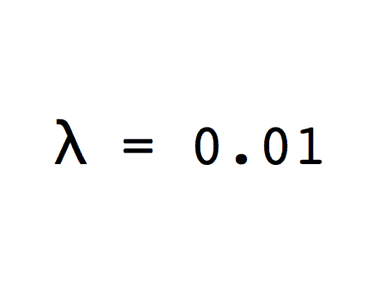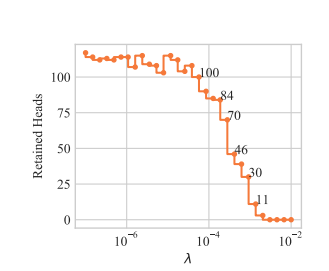LRP Head Pruning
MindSpore Golden Stick LRP module is an implementation of the LRP method for head pruning first presented in the article Analyzing Multi-Head Self-Attention: Specialized Heads Do the Heavy Lifting, the Rest Can Be Pruned and explained below.
For a complete tutorial of how to use this module please refer to the tutorial page.
Introduction
Pruning Attention Heads
The attention mechanism is a crucial component of the transformer architecture. Different studies have shown that most attention heads are not confident in their decisions and can be pruned. Since then, several algorithms have been proposed on how to intelligently prune attention heads.
LRP method
The LRP method starts from a converged model that was not necessarily specially trained to support head pruning. Then, it fine-tunes the model to support head pruning, and at the end of the fine-tuning phase some heads are pruned.
During the fine-tuning, the original Transformer architecture is modified by multiplying the representation computed by each head with a scalar gate.
That is, when moving from the standard Transformer to the modified one, the representation computed by each
Note,
Ideally, the values of the gates are either 1 (“open”) or 0 (“closed”), and the sparsity of the gates is encouraged by applying
Unfortunately, a direct implementation of this idea leads to an objective function that is non-differentiable with respect to the added gates. So instead, the algorithm uses a stochastic relaxation in which each gate is modeled as a continuous random variable drawn independently of a head-specific Hard Concrete distribution. The distributions have non-zero probability mass at 0 and 1; look at the illustration.

The non-differentiable
By varying the coefficient

(Gif is for the model trained on EN-RU WMT. For other datasets, values of
Empirically, the model converges to solutions where gates are either almost completely closed or completely open. This means that at test time we can treat the model as a standard Transformer and use only a subset of heads.
Overall, there are 3 main parameters that the user needs to know in order to get a general understanding of the algorithm backstage:
l0_penaltyThe regularization coefficient through which we control the number of pruned heads
The larger the coefficient is, the more heads are pruned
temperatureControls the relaxation of the ideal objective function
As the temperature decreases, the degree of approximation improves (at the expense of the derivatives' stability)
log_aA per head parameter indicating the “openness” of the gate associated with the head
These parameters are learned by the algorithm in the fine-tuning phase (unlike the previous two parameters that are set by the user)
(From Differentiable Subset Pruning of Transformer Heads article)

Link to the article
HeadPruning API
Our headPruning algorithm is integrated within the standard training loop, and returns a pruned model.
Create Dataset:
Create an NLP Dataset for your model.
Create optimizer:
The model parameter 'log_a' (which is introduced by the algorithm) should be defined with a high learning rate.
To define a different learning rate especially for this parameter, use the following script
params = network.trainable_params()
pruning_params = list(filter(lambda x: 'log_a' in x.name, params))
other_params = list(filter(lambda x: 'log_a' not in x.name, params))
group_params = [{'params': other_params},
{'params': pruning_params, 'lr': 0.1},
{'order_params': params}]
Load Model:
Load trained model from mindspore.
bert_model = BertModel(bert_net_cfg, True)
Create HeadPruner:
Initiate HeadPruner
from mindspore_gs.prune_heads import HeadPruningFactory, PruningType, SupportedModels
model_params = {'config': bert_net_config}
l0_penalty = 0.0015
head_pruner_config = {'model_params': model_params,
'l0_penalty': l0_penalty }
factory_dic = {"prune_type": PruningType.LRP,
"arch_type": SupportedModels.BERT,
"config": head_pruner_config}
pruner = HeadPruningFactory.get_pruner(pruner_config)
The parameters required for HeadPruner initialization are:
prune_type (Enum) – Type of pruning method.
arch_type (Enum) – Type of model to prune
config (Dictionary) - Head pruner config, contain:
model_params (Dictionary) - Parameters of model.
l0_penalty (float) – penalty value for gate calculation.
Apply model:
Repackage the model with additional functionality that supports the pruning.
bert_model_gated = pruner.apply(bert_model)
The function input is:
model - model to prune, possible with/without head.
Train Gated Model
For the fine-tuning of the model, we add a penalty factor to the loss expression
sequence_output, pooled_output, embedding_table, total_reg = \
model(input_ids, token_type_id, input_mask)
loss = ...
loss += total_reg
Train the model between 1-3 epoch.
Get mask:
mask = bert_model_gated.get_gate_values()
Prune model:
After training / fine-tuning, prune the model.
prune_model = pruner.convert(bert_model_gated)
The function has an option to get another parameter:
save_dir_path (string) - path for saving the model before pruning, and pickle file with heads to prune dictionary.
save_dir_path = '...'
prune_model = pruner.convert(bert_model_gated, save_dir_path)
Run sample
BERT on MNLI
We provide a code example for LRP pruning of Bert model in run_sample_bert.py file. It can be run using the following shell command
export DEVICE_TARGET = "GPU"
export DATA_DIR = data/MNLI/
export TRAINING_MODEL_CKPT = "..."
python run_sample_bert.py \
--device_target $DEVICE_TARGET \
--distribute "false" \
--epoch_size 3 \
--enable_save_ckpt "false" \
--enable_lossscale "true" \
--do_shuffle "true" \
--enable_data_sink "true" \
--data_sink_steps 20 \
--load_checkpoint_path $TRAINING_MODEL_CKPT \
--save_checkpoint_path "" \
--save_checkpoint_steps 10000 \
--save_checkpoint_num 1 \
--data_dir $DATA_DIR \
